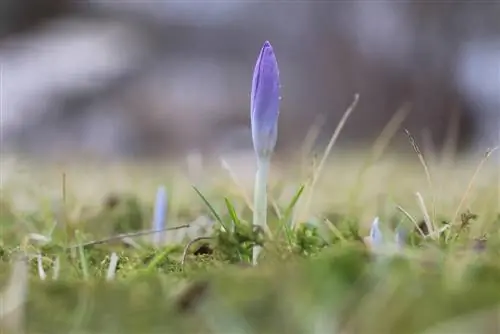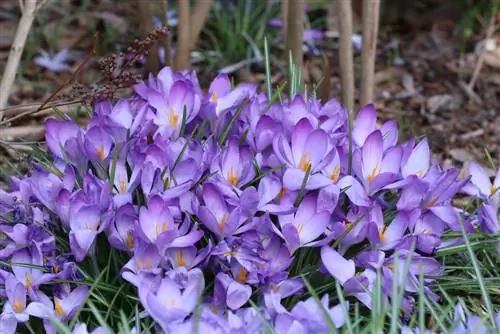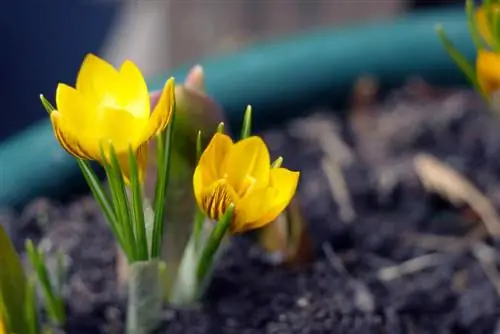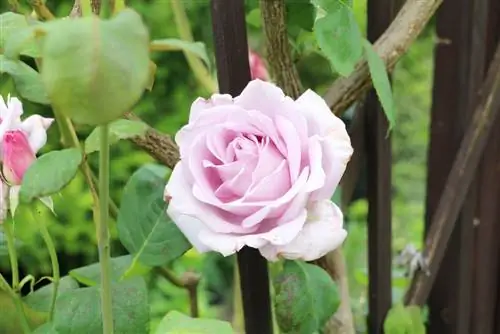- Author admin [email protected].
- Public 2023-12-17 03:39.
- Last modified 2025-06-01 06:48.
The crocus is an undemanding bulbous plant that can be planted both indoors in a pot and outdoors in a bed. There are a few varieties that give off a light, sweet scent that is also very pleasant indoors.
Location and soil for crocuses
- The onions are planted outdoors in late summer or early autumn as they require cold periods.
- Planting in pots takes place about three months before the desired flowering period.
- The bulbs need about ten weeks to root.
- The bulbs must not be planted too deep. A few centimeters below the surface is sufficient.
- Therefore, the crocuses can easily be placed in shallow bowls.
- The bulbs can be planted close together, but the bulbs should not touch each other.
As one of the first plants in spring, crocuses love sunny locations. It is a good idea to plant the bulbs in a perennial bed, as the crocuses will have bloomed by April at the latest, meaning that a bed will show colorful flowers early on. The onions are also often planted directly in the lawn like other onion plants that bloom in spring. By the time the lawn is cut for the first time, the crocuses have withered and moved back in. Crocuses are also often kept in pots or bowls indoors and are part of spring bouquets.
Crocuses indoors should also be placed in a bright and sunny location and preferably on a south-facing windowsill. The crocuses do not place great demands on their location and are very undemanding. If they are in the company of other plants, they no longer need any special fertilization. Crocuses in pots should be fertilized or the soil changed once a year. Normal compost soil is completely sufficient for this.
Temperature and watering of crocuses
Crocuses need a temperature pulse to grow. Temperatures above 7°C signal to the bulb that it is time to grow and the temperature should remain within this range during rooting. If the temperatures are below this in winter, the tuber rests. To provide this temperature stimulus for crocuses in the house, the pot can be placed on the balcony for 24 hours at cool temperatures.
If you don't have the opportunity to put the pot outside, you can also put the crocuses in the refrigerator for a day. Outdoors, the bulbs are not very difficult to care for and usually do not need to be watered.
If a long period of rain in the past is followed by a dry period of several weeks, the plants can be watered moderately. Indoor crocuses should be kept moderately moist. Waterlogging should be avoided, otherwise the onions can start to rot.
Propagate and repot crocuses

It is not necessary to transplant the bulbs outdoors. If conditions are good, the mother tuber sprouts small breeding tubers every year, which means that crocuses reproduce automatically. If there are too many crocuses growing in one place, they can be carefully dug up after flowering. The new location should provide enough space for the plants to multiply. On average it takes three years for the young bulbs to bloom.
During this time, however, the mother tuber also dies. Crocuses in pots can be placed in the garden over the summer; the soil should not dry out. If this option does not exist, the bulbs are removed from the soil after they have completely soaked in and roughly cleaned. They are stored dry and cool, for example in the basement or in a storage room, and are not planted again until autumn.
Care should be taken when digging up the onions so that young onions are not separated from the mother bulb too early. Only when these dissolve independently can they supply themselves with nutrients. The tubers should also be stored over the summer to protect them from pests such as mice. A regular check should be carried out to determine whether the environment is too humid or too dry. If the air in the room is too dry, you can put a damp cloth on the onions, otherwise they will dry out. Rooms that are too humid can lead to fungal infestation on the bulbs or early sprouting.
Pests and diseases
The only pest that can be dangerous to crocuses is the vole. The onions are a great source of food for rodents all year round. If you are afraid of voles, you can put plant baskets in hollows in the ground, put crocus bulbs in them and cover everything with soil. The edge of the plant baskets should protrude slightly to prevent voles from climbing over the edge.
If the rodents are still not put off by the onions, which they find tasty, closed cages can be made out of fine-mesh wire and buried in the ground with the onions. Waterlogging can also harm the onions because they could rot. If there is a risk of waterlogging, the soil can be mixed with sand, which increases permeability.
Care instructions at a glance
- bright to sunny location
- plant safely from voles
- water moderately
- cool temperatures as a growth stimulus
- Repotting after the plant has moved in
- Store dug up onions in a cool and dry place
What you should know about crocuses in brief

Crocuses are among the first signs of spring in the garden. The bulbs can easily be planted in places in the garden where the soil is rarely or not moved at all. Due to its low location requirements, it is also suitable as a colorful splash of color in the lawn or perennial beds in spring. Once planted, the tuber reproduces on its own, but it should be protected from pests such as voles. Crocuses in pots can be left outdoors in winter or dug up and stored in a dry place after they have moved in.
- Crocuses are only 5 to 10cm high, grow upright and bloom from the end of January to April, depending on the variety.
- And there are some beautiful varieties: you can get them in yellow, white, pink, purple and even multicolored.
- Their flower shape is cup-shaped or goblet-shaped.
- As with all spring bloomers, the planting time is September/October, where they are planted approx. 6-8 cm deep in the soil.
- Most crocuses develop small daughter bulbs that can be easily removed from the mother bulb.
- After flowering, the bulbs are carefully removed from the ground and the daughter bulb is then replanted in another desired location.
- If you don't want to put the daughter bulb somewhere else, you can just wait and do nothing.
- The crocuses multiply by themselves thanks to the breeding bulbs.
- Some species also form seeds, which they are very generous with and thus spread.
Particularly noteworthy here is the light purple Crocus tommasinianus, the fairy crocus, which blooms from the end of January. Through seeding, it is able to form entire crocus colonies and is considered to be particularly easy to spread. It is therefore very suitable for natural gardens. This is also almost the only type of crocus that still exists in the wild.
Crocuses - different types
A distinction is made between botanical species that are produced by nature itself and ornamental forms that have been specially bred by humans. Particularly attractive species are the botanical varieties 'Sieberi Firefly' with intense pink petals and an orange core, 'Blue Pearl' with leaves that shine differently blue on one flower and the bright yellow variety 'Romance'. The flower of 'Jeanne d'Arc' shines almost unreal in pure white. Remenbrance is a strong violet with silky, shiny petals, which also works excellently as an intense splash of color in the midst of many white or yellow crocuses. 'Crocus chrysanthus' impresses with its intense sunny yellow flowers and 'Crocus vernus', the Alpine crocus, has pink veined petals.
Crocuses in herbaceous beds
The little colorful creatures also look very good in bare herbaceous beds or in front of deciduous trees as well as in rock gardens.
Crocuses also like permeable soil, not waterlogging. In spring it can be a little wetter, in autumn they prefer it to be drier. They are hardy, but sensitive during flowering, so even small temperature fluctuations can cause the sun-hungry flowers to close for a short time.






